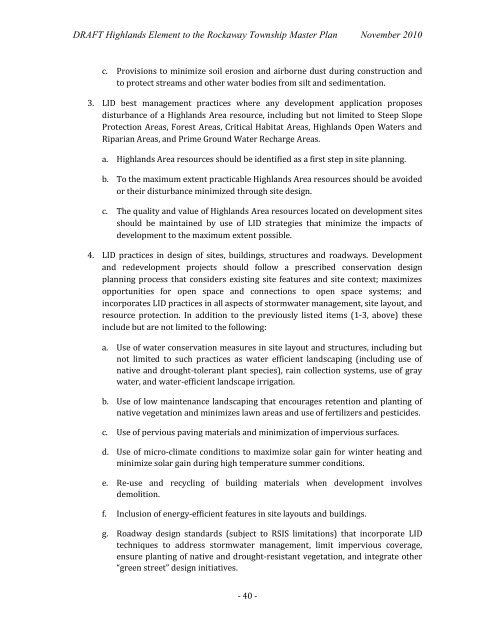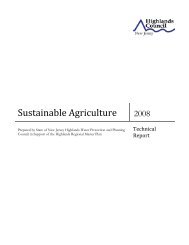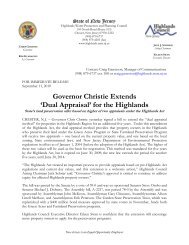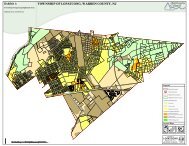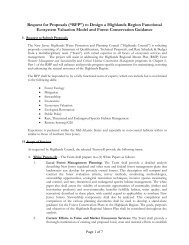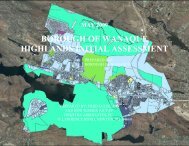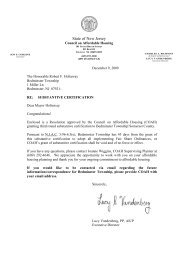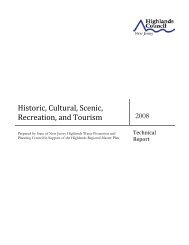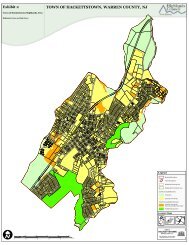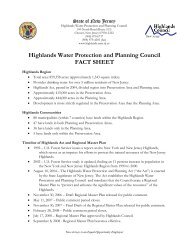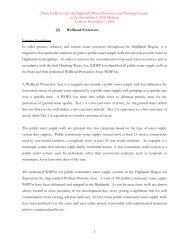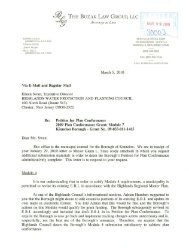Township of Rockaway DRAFT Highlands Element for Municipal ...
Township of Rockaway DRAFT Highlands Element for Municipal ...
Township of Rockaway DRAFT Highlands Element for Municipal ...
You also want an ePaper? Increase the reach of your titles
YUMPU automatically turns print PDFs into web optimized ePapers that Google loves.
<strong>DRAFT</strong> <strong>Highlands</strong> <strong>Element</strong> to the <strong>Rockaway</strong> <strong>Township</strong> Master Plan November 2010<br />
c. Provisions to minimize soil erosion and airborne dust during construction and<br />
to protect streams and other water bodies from silt and sedimentation.<br />
3. LID best management practices where any development application proposes<br />
disturbance <strong>of</strong> a <strong>Highlands</strong> Area resource, including but not limited to Steep Slope<br />
Protection Areas, Forest Areas, Critical Habitat Areas, <strong>Highlands</strong> Open Waters and<br />
Riparian Areas, and Prime Ground Water Recharge Areas.<br />
a. <strong>Highlands</strong> Area resources should be identified as a first step in site planning.<br />
b. To the maximum extent practicable <strong>Highlands</strong> Area resources should be avoided<br />
or their disturbance minimized through site design.<br />
c. The quality and value <strong>of</strong> <strong>Highlands</strong> Area resources located on development sites<br />
should be maintained by use <strong>of</strong> LID strategies that minimize the impacts <strong>of</strong><br />
development to the maximum extent possible.<br />
4. LID practices in design <strong>of</strong> sites, buildings, structures and roadways. Development<br />
and redevelopment projects should follow a prescribed conservation design<br />
planning process that considers existing site features and site context; maximizes<br />
opportunities <strong>for</strong> open space and connections to open space systems; and<br />
incorporates LID practices in all aspects <strong>of</strong> stormwater management, site layout, and<br />
resource protection. In addition to the previously listed items (1-3, above) these<br />
include but are not limited to the following:<br />
a. Use <strong>of</strong> water conservation measures in site layout and structures, including but<br />
not limited to such practices as water efficient landscaping (including use <strong>of</strong><br />
native and drought-tolerant plant species), rain collection systems, use <strong>of</strong> gray<br />
water, and water-efficient landscape irrigation.<br />
b. Use <strong>of</strong> low maintenance landscaping that encourages retention and planting <strong>of</strong><br />
native vegetation and minimizes lawn areas and use <strong>of</strong> fertilizers and pesticides.<br />
c. Use <strong>of</strong> pervious paving materials and minimization <strong>of</strong> impervious surfaces.<br />
d. Use <strong>of</strong> micro-climate conditions to maximize solar gain <strong>for</strong> winter heating and<br />
minimize solar gain during high temperature summer conditions.<br />
e. Re-use and recycling <strong>of</strong> building materials when development involves<br />
demolition.<br />
f. Inclusion <strong>of</strong> energy-efficient features in site layouts and buildings.<br />
g. Roadway design standards (subject to RSIS limitations) that incorporate LID<br />
techniques to address stormwater management, limit impervious coverage,<br />
ensure planting <strong>of</strong> native and drought-resistant vegetation, and integrate other<br />
“green street” design initiatives.<br />
- 40 -


